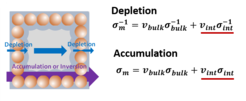Nanoionics of hybrid perovskite interfaces
M. Jung, G.Y. Kim, A. Senocrate, D. Moia, J. Maier
Optimization of interfaces in hybrid perovskite solar cells holds much of the potential to enable the technology to reach its best possible performance. Processes of charge injection, collection and recombination are sensitive to energy level alignment and to the space charge situation between the active layer and the contact materials.
The ionic properties of hybrid perovskites can have a determining effect on the interfacial situation. While electronic equilibration is expected at any semiconducting junction, the presence of ionic defects as majority carriers can “overwrite” the expected electronic behavior in terms of electrostatic potential and defect redistribution.

Our recent study on the interfaces between MAPI and oxides (TiO2 and Al2O3) has provided evidence that such effects are relevant for contact materials used in hybrid perovskite solar cells. Ion adsorption at the interface with the oxide occurs during sample preparation and is ascribed to the contact material’s surface chemistry.1
PhD student Mina Jung in our group is currently exploring design rules that will allow to implement solar cell architectures where ionic and electronic equilibration at interfaces is harnessed to optimize solar energy conversion.
1. Kim, G. Y., Senocrate, A., Moia, D. & Maier, J. Ionically Generated Built-In Equilibrium Space Charge Zones—a Paradigm Change for Lead Halide Perovskite Interfaces. Adv. Funct. Mater. 30, 1–9 (2020).
